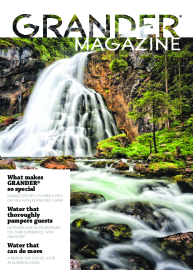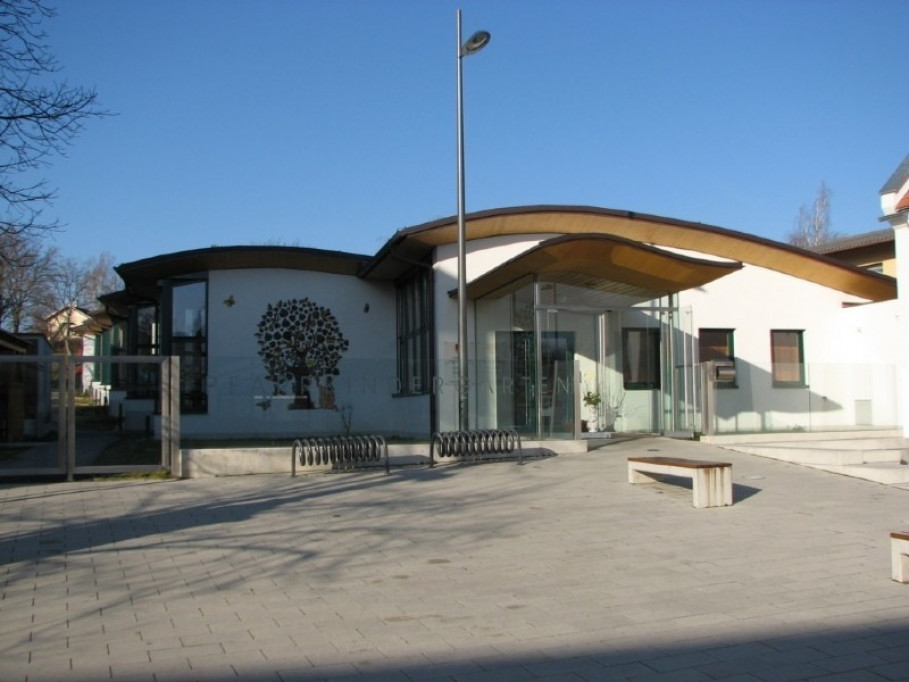GRANDER Heats Kindergarten in Oberpullendorf
Heating water with drinking water quality
- A reference in the field of Heizen & Systemschutz Österreich
The conditions in heating systems put a strain on the water used in them, and this is particularly true for floor heating systems. Slimy deposits often accumulate in the loops installed in the floor or the walls. What is more, the water is rarely heated above 40 °C in such systems. These are perfect conditions for bacteria to thrive: heating water turns murky and foul-smelling and accumulations reduce the throughput of the pipes. As a result, heat emission is reduced and in extreme cases the whole heating system can break down.
To protect the facilities, save energy, and improve the room climate, the heating system of the Oberpullendorf kindergarten was fitted with a GRANDER unit in 2004.
An analysis of the heating water more than fifteen years after the installation revealed that the heating water is still crystal clear and has drinking water quality!
Ever since the installation of a GRANDER Circulation Unit in the kindergarten’s heating system, the heating water has been closely monitored. The various analyses conducted show that all chemical and chemical-physical parameters checked not only satisfy the requirements of the ÖNORM H 5195–1 standard of the Austrian Standards Institute, they also meet the quality standards set by the Austrian Drinking Water Regulation.
The GRANDER Inline Unit restores the transport capacity, vitality, and self-cleaning properties to the heating water. Having regained its natural power to self-clean, the dirty and often foul-smelling heating water turns clear and mostly odorless in a matter of only a few months. This not only results in cost savings but also prompts a palpable and positive change in the heated rooms.
There are few areas where the GRANDER effect shows as clearly as in heating water. The samples taken from the Oberpullendorf kindergarten’s heating system prove that GRANDER starts paying off from the moment it is installed:
- Makes for clean and oderless heating water
- Lowers risk of silt deposits as biofilm formation is considerably reduced
- Reduces susceptibility to microbial contamination and corrosion
- Lowers susceptibility to deposit formation: improves throughput of heating pipes and radiators as well as the piping of floor and wall heating systems
- Saves energy
- Increases heating efficiency
- Creates a pleasant room climate
- Optimizes operating and maintenance costs
The chemical, physical, and bacteriological lab analyses produced the following results:
|
Chemical analysis |
Measured value |
Measured value |
Measured value |
Measured value |
Threshold* |
Threshold drinking water |
|
Total hardness °d |
15.5 |
15.5 |
17.6 |
16.4 |
Total hardness threshold* |
|
|
Calcium Ca [mg/l] |
75.5 |
79.8 |
79.2 |
81.9 |
-- |
400 |
|
Magnesium Mg [mg/l] |
21.2 |
18.7 |
28.9 |
21.4 |
-- |
120 |
|
Ammonium NH4+ [mg/l] |
<0.02 |
<0.02 |
0.060 |
0.027 |
-- |
0.5 |
|
Nitrate NO3- [mg/l] |
<1 |
<1 |
NA |
NA |
-- |
50 |
|
Chloride Cl- [mg/l] |
9.96 |
8.97 |
8.57 |
8.05 |
<30 |
200 |
|
Orthophosphate PO4-P [mg/l] |
<0.05 |
<0.05 |
<0.05 |
NA |
-- |
-- |
|
Sulfate SO4-2 [mg/l] |
43.0 |
NA |
33.3 |
NA |
-- |
250 |
|
Total Iron Fe [mg/l] |
0.040 |
0.075 |
0.083 |
0.026 |
-- |
-- |
|
Dissolved Iron Fe [mg/l] |
0.041 |
0.030 |
0.022 |
0.011 |
0.2 |
0.2 |
|
Chemical analysis |
Measured value |
Measured value |
Threshold* |
Threshold drinking water |
|
Total hardness °d |
14.1 |
13.5 |
Total hardness threshold* |
|
|
Calcium Ca [mg/l] |
70.8 |
63.9 |
-- |
400 |
|
Magnesium Mg [mg/l] |
18.1 |
19.6 |
-- |
120 |
|
Ammonium NH4+ [mg/l] |
<0.02 |
<0.02 |
-- |
0.5 |
|
Chloride Cl- [mg/l] |
10.0 |
21.3 |
<30 |
200 |
|
Orthophosphate PO4-P [mg/l] |
|
<0.05 |
-- |
-- |
|
Total Iron Fe [mg/l] |
0.159 |
0.070 |
-- |
-- |
|
Dissolved Iron Fe [mg/l] |
0.099 |
0.006 |
0.2 |
0.2 |
*
|
Water quantity |
Total earth alkaline metals1 |
German degrees2 |
|
up to 1.000 l |
up to 3 mmol l-1 |
up to 17 |
|
1,000 to 5,000 l |
up to 1 mmol l -1 |
up to 6 |
|
more than 5,000 l |
up to 0.1 mmol l-1 |
up to 0.5 |
|
1) The total of alkaline earth metals is given in mmol l-1 according to the International System of Units (SI). 2) German degrees are no longer in use and only stated for the reader’s convenience. |
||
|
Physical analysis |
Measured value |
Measured value |
Measured value |
Measured value |
Threshold* |
Threshold drinking water |
|
pH value a (facilities without aluminium materials) b (facilities with aluminium materials) |
7.28 |
7.74 |
7.62 |
7.78 |
a) pH 8-9.5 b) pH 8-8.5 |
6.5-9.5 |
|
Electrical conductivity [µS/cm] |
518 |
512 |
518 |
503 |
2,500 |
|
|
Colour (SAK at 436 nm) [m-1] |
ND |
ND |
0.00173 |
0.00359 |
0.5 |
|
|
Acid capacity up to pH 4.3 [mmol/l] |
3.98 |
3.84 |
4.05 |
3.62 |
-- |
|
Physical analysis |
Measured value |
Measured value |
Threshold* |
Threshold drinking water |
|
pH value a (facilities without aluminium materials) b (facilities with aluminium materials) |
7.35 |
7.28 |
a) pH 8-9.5 b) pH 8-8.5 |
6.5-9.5 |
|
Electrical conductivity [µS/cm] |
518 |
505 |
2,500 |
|
|
Colour (SAK at 436 nm) [m-1] |
ND |
ND |
0.5 |
|
|
Acid capacity up to pH 4.3 [mmol/l] |
4.33 |
3.55 |
-- |
|
Bacteriological analysis |
Measured value |
Measured value |
Measured value |
Measured value |
Threshold drinking water |
|
CFU 22° C, 72 hrs, ISO 6222 [KBE/ml] |
2 |
0 |
2 |
0 |
100 |
|
E. Coli, 37°C, 72 hrs. [KBE in 100 ml] |
0 |
0 |
ND |
ND |
0 |
|
Coliform bacteria 37°C, 72 hrs. [KBE in 100 ml] |
0 |
0 |
ND |
ND |
0 |
|
Bacteriological analysis |
Measured value |
Measured Value |
Threshold drinking water |
|
CFU 22° C, 72 Std, ISO 6222 [KBE/ml] |
43 |
10 |
100 |
* according to the Austrian H 5195-1/2 heating water standard
Examined on: October 13, 2009, May 7, 2014, November 25, 2015, April 25, 2017, July 16, 2020
The heating water’s restored vitality ensures that the children and staff at the Oberpullendorf parish kindergarten enjoy a pleasant room climate. Also the kindergarten’s drinking water is revitalized. The children’s opinion on the revitalized water they drink every day? They all agree: “Yummy!”


